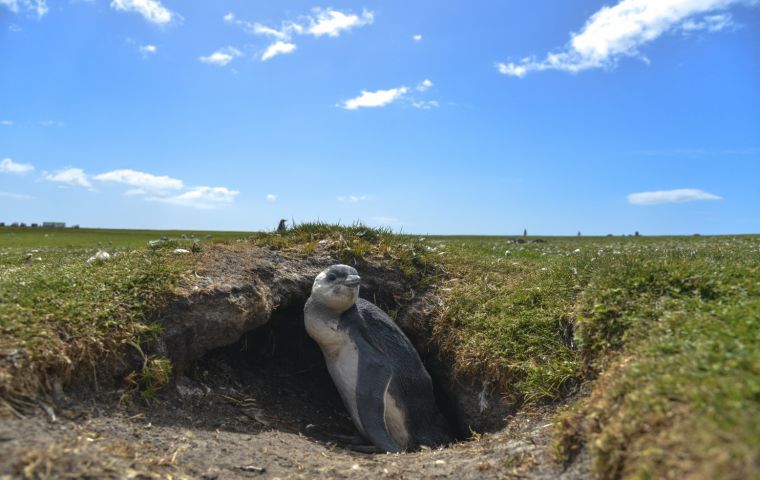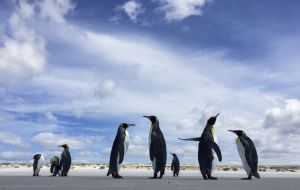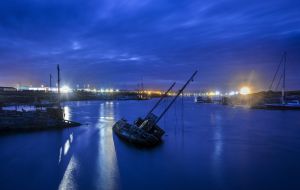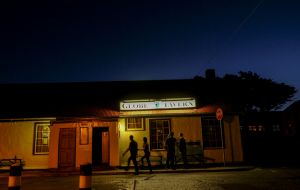MercoPress. South Atlantic News Agency
“On the Falkland Islands, a traveler’s quest to see more types of penguins than ever”
 A Magellanic penguin sits at the mouth of its burrow on Volunteer Point, Falkland Islands. (Jahi Chikwendiu/The Washington Post)
A Magellanic penguin sits at the mouth of its burrow on Volunteer Point, Falkland Islands. (Jahi Chikwendiu/The Washington Post)  Groups of King penguins hang out on the beach on Volunteer Point, Falkland Islands. King penguins are the largest of the Falklands penguins, at an average height of just over three feet tall. (Jahi Ch
Groups of King penguins hang out on the beach on Volunteer Point, Falkland Islands. King penguins are the largest of the Falklands penguins, at an average height of just over three feet tall. (Jahi Ch  A partially sunken fishing boat rests in the Stanley Harbor in Stanley, Falkland Islands. While oil exploration has started in the waters around the islands, fishing remains the country's main economi
A partially sunken fishing boat rests in the Stanley Harbor in Stanley, Falkland Islands. While oil exploration has started in the waters around the islands, fishing remains the country's main economi  As the sunlight fades, thousands of Imperial Cormorants, with a sprinkle of Rockhopper penguins, nest along the cliff tops of Sea Lion Island, the southernmost part of the Falklands. (Jahi Chikwendiu/
As the sunlight fades, thousands of Imperial Cormorants, with a sprinkle of Rockhopper penguins, nest along the cliff tops of Sea Lion Island, the southernmost part of the Falklands. (Jahi Chikwendiu/  Just after sunset, patrons gather for food, fun, dancing and drinks at the Globe Tavern in Stanley, Falkland Islands. (Jahi Chikwendiu/The Washington Post)
Just after sunset, patrons gather for food, fun, dancing and drinks at the Globe Tavern in Stanley, Falkland Islands. (Jahi Chikwendiu/The Washington Post) The Washington Post Magazine has published an interesting article on the Falkland Islands, rookeries and penguins credited to Andrea Sachs. Equally striking is Andrea who describes herself as an ornithologist in love with penguins.
”Why the fixation on penguins, you might ask. Obviously, they’re cute and silly, waddling around like little Charlie Chaplins. But I also admire their fortitude in the face of such odds as Arctic blizzards and menacing sharks. And I applaud their lifelong commitment to their mates, though I later learned that the females will flirt (and possibly more) for nest-building material. They move me in every which way, from giggles to tears. I am hopelessly hooked”.
Follows the full article:
I was bouncing around in the back seat of a Land Rover, heading toward a beach on East Falkland. My eyes swept over a desolate landscape of dirt patches punctuated by green lumps. I searched for signs of life. In the distance, I noticed a cluster of dark smudges.
“Those are penguins,” Esther Bertram said from behind the wheel.
I asked her to please stop the car and ran half-mad toward the birds. I stared; they stared. I could’ve cried with happiness; they couldn’t have cared less. I climbed back into the vehicle, giddy.
“You’ll see more,” she assured me.
If my projections were accurate, four species more.
Most birders aspire to see hundreds — if not thousands — of species in their lifetime. My number is set at 17, and they all belong to the same family: Spheniscidae or, in non-ornithologist parlance, penguins.
Why the fixation on penguins, you might ask. Obviously, they’re cute and silly, waddling around like little Charlie Chaplins. But I also admire their fortitude in the face of such odds as Arctic blizzards and menacing sharks. And I applaud their lifelong commitment to their mates, though I later learned that the females will flirt (and possibly more) for nest-building material. They move me in every which way, from giggles to tears. I am hopelessly hooked.
Since embarking on my penguin quest years ago, I have witnessed four species in the wild. (Zoos and aquariums don’t qualify.) I have seen little blue, or fairy, penguins in Australia and New Zealand; Humboldt penguins in Patagonia; and African penguins in Namibia. On a January swim in Ecuador, I nearly smashed a Galapagos penguin with my head when I darted to the surface for air.
If you do the math, you will realize that my progress is slow.
The number is low not for a lack of commitment or obsession. It’s logistics. Most of them live in inhospitable places: on glaciers, remote islands or rocky cliffs accessible only by ocean vessel or climbing gear. In addition, the flightless birds inhabit less surface area than other winged creatures. Land and sea, no sky
To speed up my count, I had to find a destination dense with penguin species. Chile is home to four kinds, but the macaronis live offshore, outside the tourist cone. Six species reside in Antarctica; however, turbulent weather and restrictions on cruise ships can impede viewings. The Falkland Islands has five species and more than a million penguins, including the world’s largest breeding population of gentoos and nearly 40 percent of the world’s southern rockhopper population. The birds inhabit beaches, craggy cliffs, heathland and coastal grasslands, all within reasonable reach.
On a summery February morning, Esther, chief executive director of Falklands Conservation, and Andy Stanworth , a conservation manager, showed me how easy it was to commune with penguins: as simple as driving to the beach.
“They are everywhere,” Andrew said as we stood among several groupings of the birds on the sand and in the dunes. “They’re part of the scenery.”
Hearing that news, I broke out in a “Happy Feet” dance.
The Falkland Islands, a British overseas territory in the South Atlantic, is a broken puzzle with more than 778 island pieces. (Opponents to U.K. sovereignty refer to the country as the Malvinas, the Argentine name.) One commercial flight flies weekly between Punta Arenas, Chile, and Mount Pleasant Airport, a military station on East Falkland, the largest island. The Royal Air Force also provides service twice a week from England. Flight time is about 18 hours, including a refueling stop on Ascension Island.
Photography is not permitted at the airport, so I don’t have proof of the stone penguin statue that greets passengers after disembarking. But I can reveal that I patted the bird on its head, a reflexive move. I can also share that a serviceman informed me of an island tradition: Anyone who touches the statue improves his or her chances of returning to the islands.
The penguin breeding season coincides with the tourist invasion. Both occur during the Southern Hemisphere’s late spring and summer months, roughly September to March.
The southern ocean is large, and there is very minimal land mass for breeding,” said Megan Tierney, a marine ecologist with the South Atlantic Environmental Research Institute in Stanley, the capital.
During this period, the archipelago transforms into a giant maternity ward (and docking station for cruise ship passengers). The adults lay and incubate their eggs. The chicks hatch. The weeks-old fledglings gather in protective creches while their parents forage for food in the ocean. The youngsters wait for dinner, vocalizing their hunger and impatience — loudly.
“It’s the sound of the Falklands,” said Andy.
Two species, the gentoo and the king, inhabit the Falklands year-round. The southern rockhopper, Magellanic and macaroni are seasonal guests. When the weather starts to cool, they depart for waters up the South American coast and around South Georgia Island and Antarctica. But even in the offseason, the penguins outnumber the humans.
I couldn’t imagine a better ratio, and place, on Earth.
The tourist map is adorable. Eric Carle-like illustrations of whales, sheep, foxes, sea lions and penguins dot the coves and coastlines of the two largest islands as well as the smaller ones, such as Carcass, Flat and Lively. But the navigational aid is deceiving. The uninitiated might mistakenly think that they can hop into their rental car and zoom off to Cape Dolphin or Bull Point or Bertha’s Beach and cavort with the wildlife. What they won’t know until they set off is that there is only one main two-lane road on East and West Falkland (a ferry connects the two sections), a few intersections and no traffic lights. The paved portions sometimes dissolve into a crumble. Most of the excursions require a four-wheel-drive vehicle and steely nerves. Instead of signs, drivers rely on the topography. Cattle grids, roving sheep and haphazard rabbits intensify the driving experience.
The majority of penguins live on private land that is often part of a working farm. (A few exceptions: Gypsy Cove, a Magellanic habitat near Stanley, and a gentoo colony near the ferry port on East Falkland.) The locals are typically generous and will unlock the gate if you call and ask. But you need to know the phone number and catch the owners at home.
Whenever possible, I hitched a ride with Falklands Conservation. The nonprofit organization frequents wildlife sites for research, such as seabird monitoring, and outreach activities, like a Sunday outing to Elephant Beach Farm with Watch Group, an environmental program for children.
The caravan of cars parked near the beach, a banner of white sand speckled with rocks. The kids grabbed garbage bags to collect litter and zoomed by a pack of penguins. The birds looked curiously at the strange creatures, who were equally clumsy and clownish.
On Elephant Beach, three species mingled as if they were at a social mixer. I couldn’t tell them apart, so Esther and Andy described their distinguishing features.
The gentoo are inquisitive, Esther said, and the “most elegant,” with their orange lipstick, white eye shadow and red shoes. The Magellanic are “quite quirky, and their behavior is odd,” Andy said. They wear the traditional tuxedo colors, decorated with black bands, and emit a sound that resembles a donkey’s heehaw — hence their nickname, jackass. The rockhoppers stand out from the crowd with their red eyes and beak, yellow feather headdress and feistiness.
“They are the most amazing,” Esther said. “They boing along like bouncy balls.”
“They’re aggressive little balls of angst,” added Andy.
As if on cue, a rockie pogo-ed over to a posse of gentoos and Magellanics and started fussing. Its molting feathers flapped around like a dislodged toupee. The group fired back with pecks and pushes. I watched the squabbling species with fascination and amusement. I crossed the three kinds off my list but knew that we would see each other again.
The Falklands’ largest colony of king penguins — about 1,000 adults and 500 chicks — resides at Volunteer Point, a toe of land three hours from Stanley. The site draws crowds on cruise ship days who arrive on pre-arranged tours. Signs point this way to the gentoos, that way to the Magellanics, over here for the kings.
“Wow, they’re good-looking,” Andy said of the kings congregating in a cordoned-off breeding area.
The second-largest penguin, after the emperor, is indeed stunning. They are statuesque and look haute couture in velvety black hoods splashed with citrus colors. But I also found them disturbing. Measuring three feet tall and weighing 35 pounds, they are the size of a 3-year-old.
They walked to the ocean single file, wings flapping — the same formation as the Beatles crossing Abbey Road. They babbled in an eerie voice. On the shore, they lined up facing the water and stood as still as statues. One by one, they dove into the water, a flash of black feathers glistening in the waves.
Of the five species, the macaroni is the most elusive. It doesn’t even appear on a local map highlighting wildlife-viewing sites. According to Falklands Conservation, about two dozen breeding pairs nest among the rockhoppers, which look like the macaroni’s runtier twin. Both are crested penguins with plumes that spring from their heads like streamers. Experts differentiate the two by the location and color of the feathers and the size and hue of the beak. Macaronis also are huskier and have a unibrow.
Kidney Island, a nature refuge accessible by boat from Stanley, is a roofless aviary. Falkland steamer ducks bob on wavelets by the beach. The endemic Cobb’s wren hides in the towering tussock grass. Every evening, hundreds of thousands of sooty shearwaters fly circles around the island. Once the sun sets, they drop like hailstones onto the ground and scurry into their burrows.
Our group included Nick Rendell, an environmental officer with the government’s Environmental Planning Department. Nick last spotted a macaroni several years ago.
We climbed a steep slope, stepping gingerly to avoid disturbing slumbering sea lions. I was slightly terrified each time I set a foot down in the tall grass, not knowing what my toe would touch.
We crossed over to the other side of the island and peered through scrubby brush at a sheer rockface. Rockhoppers perched on dizzying ledges.
Down below, the waves crashed against the island’s rough edges, carrying adult penguins returning from a fishing expedition.
Up ahead, I heard a rustle followed by an excited shout.
“We have a macaroni,” Nick announced.
I crept up to Nick and leaned over the precipice. The danger was worth it: I saw the unibrow fluttering in the breeze, and it was a spectacular sight.
I had completed my task in the Falklands in six days, an unimaginably speedy time frame. But I wasn’t over the penguins. Instead, I had fallen even deeper.
Despite my obsession, my understanding of penguins was as slight as “Penguins of Madagascar.” But I could use my second week to observe and learn, to really get to know the birds.
At Gypsy Cove, the trail to the Magellanic penguins is open day and night. A rope on both sides of the pathway protects their burrows from an ill-placed boot. The barrier also safeguards visitors from the buried mines left over from the 1982 war with Argentina. (A lightweight penguin won’t set off the explosives, but a person could.)
I visited several times, never tiring of watching their daunting fish-and-feed routine. How at dusk the adults would return from sea and assemble along the shoreline with the family’s meal. How one penguin would break rank and head for the hill. How it would teeter upward, sometimes stopping, retreating, starting again. How the parent and the chicks would reunite outside the burrow, high above the lapping waves. How the sky would blacken and the stars would sparkle, and still the youngsters would wait.
On Sea Lion Island, a 35-minute flight from Stanley, several of the lodge’s rooms overlook a colony of gentoos. If I opened the curtains and craned my neck to the right, I could eye a few penguins without leaving bed. Their white breasts glowed in the dark.
The manager, Micky Reeves, leads a guided tour of the island, a nature reserve with one hotel and no rodents. The land measures only three square miles, but we spent several hours driving around. Our first stop was on a windy cliff that buffeted a beach occupied by the island’s eponymous resident. A bull lay with his harem, groaning with contentment.
Before dinner, I ventured out to a gathering of juvenile gentoos a few yards from the lodge’s front door. I entered the circle of birds and plopped down on the dirt. A few penguins slowly approached. More came over. Nearly a dozen formed a loose embrace around me. They tilted their heads as if asking, “Who — or what — are you?”
One brazen gentoo pecked at my boot. Noticing a strap on my coat sleeve, it leaned in closer, beak ajar. It tugged on the fabric and chewed a little. It then took a small step back, turned its head and threw up regurgitated fish.
At Port Stephens, Peter and Ann Robertson waited at the landing strip in their dusty pickup truck. They had driven over for several reasons: to pick up guests and supplies from Stanley and to extinguish a fire in case of an emergency. Their grandson, the pilot, took off without incident.
The couple — he grew up in the Falklands, she in Argentina — own 58,000 acres at the camp settlement on the southwest coast of West Falkland. They rent out a self-catering cottage steps from their house and encourage visitors to ramble around their property.
On the drive to the beach, Peter provided me with detailed instructions on where to hike. He also pointed out landmarks, such as a mountaintop radar site on a neighboring property that the Brits use to keep an eye on the Argentine coast.
“Next stop is the South Pole,” said the vivacious 83-year-old. “Just over the ridge.”
Over the loud rattle of the truck, he chatted about his life. His grandfather had managed a farm on West Falkland in the early 1900s, back when it was owned by the British conglomerate Falkland Islands Co. Peter had spent eight years in Europe and Argentina but returned in 1969 — the third generation of Robertsons to work the land and the first to own it.
“This job was beckoning,” he said. “This was my home.”
Peter has since retired, though he still wears a boiler suit. His son now oversees 9,500 sheep and 70 cows that roam so far and wide I never saw them.
Port Stephens is remote and isolated, especially during winter, when harsh weather conditions can wreck the only road and the local airline reduces service to the area. In the warmer months, the Robertsons will stock up at the twice-weekly store at Fox Bay, 45 miles away. During the colder season, the families supplement bought goods with stockpiled sundries and produce they have grown and pickled and preserved. The islanders’ reliance on nature’s bounty goes back many generations, though tastes have changed, as have positions on wildlife.
“We would take 2,000 penguin eggs as a kid,” he said. “The penguins are just part of the landscape. You never think about them.”
Since 1999, the Falklands government has banned the harvesting of seabird eggs. However, islanders can buy a license to collect gentoo eggs on their own land. Bakers say the whites make tasty meringue.
When Peter dropped me off, gentoos were thronging the beach. He pointed to a knoll where a dozen pairs of kings lived. Pockets of Magellanics occupied a surrounding crust of earth. He told me to go around the mountain to find the rockies.
A sea of birds parted as I waded in, some running hard on their graceless legs. I noticed several decomposing gentoos that had either died from red tide or because their parents had never returned with food.
Close to the water, I stumbled on large smudgy prints that looked as if a body had been dragged across the sand. As I was studying the shapes, a sea lion bull surfaced and thumped up the beach. The gentoos fled for higher ground. Behind the predator, penguins waited to surf to shore.
The sea lion eventually returned to the water. He swam back and forth, daring the penguins to cross the line.
I looked around and realized my potentially perilous situation. I was in the middle of a penguin colony, normally a prime position but not when a sea lion is looking for his next meal
I heard rumors. Somewhere in the Falklands were “other” penguins. Maybe even an 18th species-in-the-making.
Over the years, islanders have reportedly spotted an Adelie and a chinstrap. Most likely, the Antarctica-based penguins lost their bearings and drifted too far north. Residents have also discovered penguins with aberrations. Tim Wilson, a police officer and penguin aficionado, has seen an albino rockhopper and is searching for a coffee-colored rockie. He has evidence of its existence: an online photo.
I also picked up a buzz about hybrids — the progeny of a macaroni and a rockhopper. I started asking around.
“I’ve seen pictures from Saunders Island,” said Peter.
“There’s always hope,” said Micky, of Sea Lion Lodge. “Just look at every penguin and make sure they are who they are.”
I visited Megan at work. The marine ecologist tracks penguins for her job, so I asked her to tell me all about the hybrids. She said the mac-ockie (or rock-aroni) is larger than the rockie and slightly smaller than the macaroni. It dons a crest of feathers similar to the rockie. The chunky beak and dab of pink on the corner of its lip, however, are inherited from the macaroni.
They look different enough that you can pick them out,” she said.
And where could I find one?
The rockies and macaronis revisit the same colony and breeding site every year. Last summer, Megan discovered a hybrid that had returned to its nest and partner on Berkeley Sound. The couple had laid eggs, but unfortunately the chicks didn’t survive and the pair departed for the winter migration.
The odds of seeing a hybrid were low. But I knew I would have another opportunity. I had a return visit in my future. A prophecy foretold by a stone penguin.
Andrea Sachs is a Washington Post staff writer. To comment on this story, email wpmagazine@washpost.com or visit washingtonpost.com/magazine.
If you go
The most accessible penguin site is at Gypsy Cove, about 10 minutes by car from Stanley. To visit Bertha’s Beach (lots of gentoos) or Volunteer Point (so many kings), contact the property owners or sign up for a tour (see the tourist office contact below).
Visitors to Sea Lion Island (sealionisland.com) and its lodge can walk — and sleep — among the gentoo, Magellanic and rockhopper penguins. Kevin and Hattie Kilmartin organize visits to their seabird-rich property, Bluff Cove Lagoon (falklandpenguins.com).
For more information on wildlife-viewing opportunities: Falklands Conservation (falklandsconservation.com) and Falkland Islands Tourist Board (falklandislands.com).




Top Comments
Disclaimer & comment rules-

Read all commentsPS. The Spanish word malvinas is a translation from the French word malouines. Period.
Sep 11th, 2016 - 07:38 pm 0Philippe
Commenting for this story is now closed.
If you have a Facebook account, become a fan and comment on our Facebook Page!